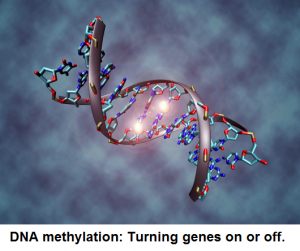 We have found genes that are switched on in one twin and switched off in the other twin – Professor Tim Spector.
We have found genes that are switched on in one twin and switched off in the other twin – Professor Tim Spector.
An article in the NZ Herald highlights a concept that is starting to become more mainstream in the public eye: that the fate of your health and genetic expression sits squarely in your lap.
“Epigenetics” and “behavioural epigenetics” is the emerging science that explains how our genetic expression is altered within our lifetime, for better or worse, dependent upon your thoughts and actions. It refers to functionally relevant modifications to the genome that do not involve a change in the nucleotide sequence. This means genes are either turned on or off, and alter how proteins are produced, which make up the functional elements of our bodies.
Listen to a brief introduction on epigenetics by Bruce Lipton, PhD.
Masha and Dasha Krivoshiyapova were born January 4th, 1950 as conjoined twins. They were joined at the hip in a unique way which made surgical separation impossible. Their unique connection included three legs shared between them, a shared single lower intestine, four kidneys utilised by one bladder, one shared reproductive system and a circulatory system that pumped the same blood through both women’s bodies.
This unique connection caught the attention of Russian scientists. Two individuals with shared blood, nutrition, exercise and genetics created a living experiment. Masha and Dasha spent 40 years in an institution where scientists did experimentation on them, sometimes horrific. The medical practitioners were baffled at the way each woman’s body handled disease. Neither twin would be sick at the same time! In fact, Dasha seemed far more vulnerable to illness than her sister.
When the bacteria or virus was present in both women, why would Dasha get sick and Masha not when they both had the same genes?
How is it possible that their health was so different? Being conjoined meant they breathed the same air, drank the same water, shared the same nutrition, sleeping, and exercise habits. If their blood was the same, why was it that when Dasha got the flu, Masha got sick much later, or not at all? Why was it that they contracted childhood diseases at different times? Medical doctors were confused.
“Essentially, epigenetics is the mechanism by which environmental changes alter the behaviour of our genes,” says Professor Tim Spector. “This involves a process known as methylation, which occurs when a chemical known as methyl, which floats around the inside of our cells, attaches itself to our DNA. When it does so, it can inhibit or turn down the activity of a gene and block it from making a particular version of a protein in our bodies.”
 All sorts of life events can affect DNA methylation levels in our bodies: diet, illnesses, ageing, chemicals in the environment, smoking, drugs and medicines.
All sorts of life events can affect DNA methylation levels in our bodies: diet, illnesses, ageing, chemicals in the environment, smoking, drugs and medicines.
Thus epigenetic changes produce variation in disease patterns. And recent experiments carried out by Spector and his colleagues, in which they have looked at methylation levels in pairs of identical twins, back the theory.
“We have studied identical twins who have different tolerances to pain and shown that they have different states of methylation. We have also produced similar results for depression, diabetes and breast cancer. In each case, we have found genes that are switched on in one twin and switched off in the other twin. This often determines whether or not they are likely to get a disease.”
Neurological health will dictate genetic health downstream.
Studies have shown how spinal stimulation of the nervous system alters the response of “immediate early genes”. Immediate early genes are genes which are activated first in rapid response to a wide variety of cellular stimuli before any proteins are actually made.
Interference to the function of the spine alters how immediate early genes produce proteins, which then change how a cell’s mitochondria produces oxygen, leading to “free radical” formation. Free radicals are oxidants which damage cells. This has lead to the popularity of “antioxidants”, however, a dysfunctional nervous system will consistently keep producing free radicals leading to DNA methylation, turning genes on or off.
The solution to the mystery of Masha and Dasha is that the twins had two totally separate neurological systems.
Your nervous system is intimately connected to your immune system. It’s not the microorganisms alone that cause illness; it’s the inability of your nervous system to properly direct your immune system. The function of your nervous system and genetic expression is the key to wellness and is up to you.
References:
McKie, R. Identical twins’ genes tell diverse tales. NZ Herald. June 8, 2013.
© Dr Neil Bossenger 2013

